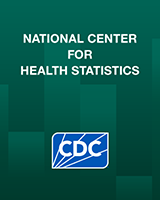
NCBI Bookshelf. A service of the National Library of Medicine, National Institutes of Health.
Prevalence of adults aged 20 and over with severe obesity, by demographic characteristics: United States, 2017–March 2020
| Characteristic | Both sexes | Men | Women | |||
|---|---|---|---|---|---|---|
| Sample size | Prevalence percentage (95% confidence interval) | Sample size | Prevalence percentage (95% confidence interval) | Sample size | Prevalence percentage (95% confidence interval) | |
| Total (age adjusted) | 8,295 | 9.2 (8.0–10.6) | 4,051 | 6.6 (5.3–8.1) | 4,244 | 111.7 (10.0–13.7) |
| Total (crude) | 8,295 | 9.0 (7.8–10.3) | 4,051 | 6.4 (5.1–8.0) | 4,244 | 11.4 (9.7–13.3) |
| Age group (years): | ||||||
| 20–39 | 2,489 | 29.7 (7.7–12.0) | 1,177 | 27.0 (4.7–10.1) | 1,312 | 1,212.4 (9.8–15.3) |
| 40–59 | 2,765 | 210.7 (8.9–12.8) | 1,320 | 28.1 (5.5–11.5) | 1,445 | 1,213.2 (10.0–16.9) |
| 60 and over | 3,041 | 6.1 (5.2–7.2) | 1,554 | 3.5 (2.6–4.5) | 1,487 | 1 8.3 (6.8–10.0) |
| Race and Hispanic origin: | ||||||
| Non-Hispanic white | 2,866 | 3,49.5 (7.9–11.3) | 1,432 | 46.8 (5.1–8.9) | 1,434 | 1,3–512.0 (9.8–14.6) |
| Non-Hispanic black | 2,213 | 4,514.0 (11.9–16.3) | 1,058 | 47.9 (6.3–9.7) | 1,155 | 1,4,519.1 (16.0–22.6) |
| Non-Hispanic Asian | 1,014 | 51.8 (1.0–2.8) | 466 | 52.4 (0.9–5.1) | 548 | 51.1 (0.2–3.3) |
| Hispanic | 1,806 | 7.4 (6.1–8.9) | 880 | 6.0 (4.2–8.4) | 926 | 8.8 (7.0–10.9) |
| Family income relative to federal poverty level (FPL): | ||||||
| 130% or less FPL | 2,019 | 610.9 (8.2–13.9) | 892 | 7.4 (5.3–9.9) | 1,127 | 1,613.5 (10.0–17.7) |
| More than 130% through 350% FPL | 2,815 | 611.8 (10.1–13.6) | 1,400 | 68.8 (7.1–10.8) | 1,415 | 1,614.5 (11.8–17.4) |
| More than 350% FPL | 2,312 | 6.9 (5.4–8.6) | 1,189 | 4.6 (2.9–6.8) | 1,123 | 19.5 (7.0–12.4) |
| Education: | ||||||
| Less than high school diploma | 1,538 | 77.6 (5.8–9.6) | 803 | 73.3 (2.0–5.1) | 735 | 112.2 (9.6–15.3) |
| High school diploma or some college | 4,709 | 811.3 (10.3–12.4) | 2,259 | 89.0 (7.2–11.0) | 2,450 | 1,813.5 (11.6–15.7) |
| College degree or above | 2,037 | 6.1 (4.3–8.5) | 984 | 3.3 (1.9–5.4) | 1,053 | 18.5 (5.7–12.2) |
Significantly different from men.
Significantly different from those aged 60 and over.
Significantly different from non-Hispanic black adults.
Significantly different from non-Hispanic Asian adults.
Significantly different from Hispanic adults.
Significantly different from those with family income more than 350% FPL.
Significantly different from high school diploma or some college.
Significantly different from college graduate or above.
NOTES: Severe obesity is defined as a body mass index of greater than or equal to 40 kg/m2. Except where reported as crude estimates, estimates were age adjusted by the direct method to the projected U.S. Census 2000 population using the age groups 20–39, 40–59, and 60 and over. Statistical comparisons were not performed on crude estimates. Pregnant women were excluded from the analysis.
SOURCE: National Center for Health Statistics, National Health and Nutrition Examination Survey, 2017–March 2020 prepandemic data files.

NCBI Bookshelf. A service of the National Library of Medicine, National Institutes of Health.